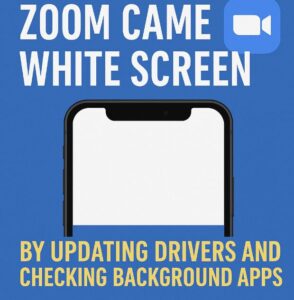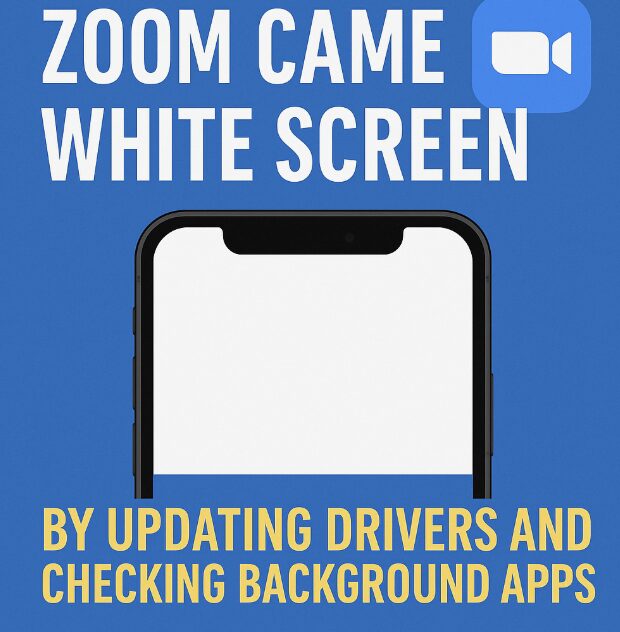Imagine you’re about to join an important Zoom meeting. You open the app, everything loads—but your camera window is completely white. No video. No error message. Just a blank, glowing rectangle where your face should be. It’s frustrating, especially when you’re under pressure or in a professional setting.
The white screen issue on Zoom is more common than you might think, especially on Windows laptops. It often happens suddenly—your camera was working fine yesterday, and now it’s not. Thankfully, you’re not alone. This issue has been widely reported on support forums and the Zoom community, and most users were able to fix it by updating their camera drivers and managing background apps that interfere with Zoom’s access to your webcam.
In this post, we’ll go step-by-step through the solutions that have helped thousands of users bring their camera back from the white void. Whether you’re using Zoom for work, school, interviews, or catching up with friends, let’s make sure your camera actually shows your face.

What Causes the Zoom White Screen Camera Issue?
The white screen issue usually happens when Zoom can’t correctly access your webcam. But the root cause can vary depending on your setup.
Here are the most common triggers:
Outdated or incompatible camera drivers
Conflicts with other apps using your webcam in the background (like Skype, OBS, or Teams)
Zoom’s video rendering settings not playing well with your graphics card
Missing Windows permissions for camera access
Corrupted Zoom installation files or system cache
These are all fixable with a few tweaks, no advanced tech skills required.
Step 1: Update Your Camera Drivers
The most reliable solution shared by Zoom community members is updating your webcam drivers. A surprising number of users had outdated or generic drivers that Windows failed to update automatically.
Here’s how to update manually:
Press Windows + X and select Device Manager
Expand Cameras or Imaging Devices
Right-click your camera (e.g., “HD Webcam” or “Integrated Camera”) and choose Update driver
Select Search automatically for drivers
If Windows says the best driver is already installed but you still have issues, visit your laptop manufacturer’s website (e.g., Dell, Lenovo, HP) and search your device model. Download the latest camera driver directly and install it.
Alternatively, if your camera is external (like Logitech), visit the Logitech Downloads page to get the latest version.
Step 2: Close Background Apps That Use the Camera
Sometimes, another app is quietly using your camera in the background—blocking Zoom from accessing it properly.
Apps that commonly interfere include:
Skype
Microsoft Teams
OBS Studio
Discord
Camera app (default on Windows)
Antivirus webcam protection (e.g., Avast, McAfee)
To shut them down:
Press Ctrl + Shift + Esc to open Task Manager
Under the Processes tab, look for any app that might be using your webcam
Right-click and select End task
Then restart Zoom and check your camera again. You can test it before joining a call by clicking your profile icon > Settings > Video and looking at the preview window.
Step 3: Change Zoom’s Video Rendering Settings
Zoom allows you to change how your video is processed, which can solve compatibility issues with specific cameras or graphics hardware.
Here’s how to do it:
Open Zoom and go to Settings > Video
Click Advanced (bottom right)
Under Video Rendering Method, switch from Auto to Direct3D11 or GDI
Also toggle “Optimize video quality with de-noise” off
Test your video after each change. Many users found that switching from Auto to GDI or Direct3D11 fixed the white screen instantly.
Step 4: Grant Camera Permissions in Windows
If Windows doesn’t let Zoom use your camera, the app simply won’t show any image—even if everything else is working.
To check:
Go to Settings > Privacy & security > Camera
Make sure Camera access is turned on
Make sure Let apps access your camera is also turned on
Scroll down and confirm that Zoom Meetings is listed and turned on
After enabling access, restart Zoom and recheck the video.
Step 5: Reinstall Zoom Cleanly
If none of the above worked, it’s possible that Zoom’s installation itself is corrupted.
Follow these steps:
Press Windows + R, type
appwiz.cpland press EnterFind Zoom, right-click, and choose Uninstall
Once done, delete leftover files:
Open File Explorer and go to
C:\Users\[YourUsername]\AppData\Roaming\ZoomDelete the Zoom folder
Restart your PC
Download the latest version from the official Zoom download page
After reinstalling, log in again and test your camera in the Settings > Video tab.
Step 6: Roll Back Drivers if the Problem Started Recently
If your camera was working fine a few days ago and suddenly broke after a Windows update or driver change, rolling back to a previous version might help.
Open Device Manager
Right-click your camera and select Properties
Go to the Driver tab
Click Roll Back Driver (if available)
This reverts your webcam to the previously working version. Restart your computer and open Zoom again.
Step 7: Test the Camera Outside Zoom
If you’re still unsure whether the issue is Zoom-specific, test your webcam with another app.
Try the built-in Camera app in Windows:
Press Windows + S, type Camera, and open the app
If you see video, your camera is working
If you also see a white screen here, the issue is system-level
In that case, consider reinstalling the camera driver again or testing with an external webcam as a workaround.
Step 8: Temporarily Disable Security Software
Some antivirus software includes webcam protection features that may block Zoom silently.
If you’re using software like:
Bitdefender
Avast
Norton
Kaspersky
Try disabling the webcam protection feature temporarily. Then relaunch Zoom and check your video.
If the issue goes away, configure your antivirus to allow Zoom access to the webcam permanently.
Step 9: Check for Conflicts with Virtual Camera Software
Are you using OBS, Snap Camera, or similar tools for fun video effects? These programs can cause Zoom to default to a virtual camera that’s not working.
To fix:
In Zoom, go to Settings > Video
Click the drop-down arrow next to Camera
Select your real webcam (e.g., “Integrated Camera” or “Logitech HD Webcam”)
If a virtual cam is selected by default, switching to your real camera often solves the issue instantly.
Also, try uninstalling any virtual cam drivers if you don’t use them actively.
If You’re Using a Mac
While this post mainly covers Windows systems, the white screen issue can also happen on macOS—especially if permissions are denied.
If you’re on a Mac:
Go to System Settings > Privacy & Security > Camera
Make sure Zoom is allowed
Also check System Settings > Screen Recording and Microphone
Restart Zoom
If that doesn’t work, try launching Zoom in Safe Mode or create a new user account on your Mac to test if the issue is user-specific.
When to Try a USB Webcam Instead
If nothing works and you’re still seeing a white screen—especially on older laptops with aging built-in webcams—it might be time to test with a USB webcam.
Models like the Logitech C920 or Razer Kiyo are plug-and-play and highly reliable for Zoom. They bypass most driver issues and are usually recognized instantly.
You can explore trusted webcams on online electronics stores if you’re considering an upgrade.
Make Zoom Video Work Every Time
Fixing a white screen issue on Zoom doesn’t require tech wizardry—just a structured approach. Here’s a quick checklist:
Update your webcam drivers manually
Close all other apps that might be using your camera
Change Zoom’s video rendering method
Grant proper camera access in Windows
Reinstall Zoom cleanly if needed
Avoid virtual camera software or set Zoom to use your real webcam
If you’re still struggling, switching to an external webcam or reaching out to Zoom support might be your best move. You can also visit the Zoom troubleshooting center for advanced support and community solutions.
No one wants to be the person stuck on camera mute because of a tech glitch. With these fixes, you’ll be back on screen—on time, every time.
